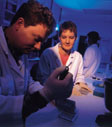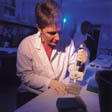 Building
a better vegetable The ultimate goal is not to have future generations of parents imploring children to eat their Arabidopsis or to have health food restaurants topping avocado sandwiches with Arabidopsis sprouts. It's to identify and isolate the genes that make sufora phane so that they can be transplanted into a variety of fruits and vegetables more amenable to the American palate, a sort of bringing-the-mountain-to Mohammed approach to the challenge of getting plant foods into the stom achs of the world's population.
For that matter, high-sufora phane broccoli, high-lycopene tomatoes and high beta-carotene cauliflower are already available in the nation's vegetable bins. "If we can enrich our foods with ingredients that induce phase 2 enzymes, we might have a better variety of fruits and vegetables for cancer prevention," Abel notes. That being said, the days of anti-carcinogenic chocolates or tumor-busting ice cream sundaes are a long way down the road. But sufora phane-fortified apples? Check with Abel in a few years. He might have good news for a nation of vegetable-avoiders.
Home |
Table of Contents |
To our Readers |
Building on Basics UC Davis Health System | © 2000, 2001, 2002 UC Regents. All rights reserved. |
Gross prepares an assay for identifying sufora phane. |
 "Value-added
crops are an emerging, very popular part of agricultural science,"
Abel observes. "Getting larger yields is still a concern but
the future lies in equipping crops with new traits."
"Value-added
crops are an emerging, very popular part of agricultural science,"
Abel observes. "Getting larger yields is still a concern but
the future lies in equipping crops with new traits." 
